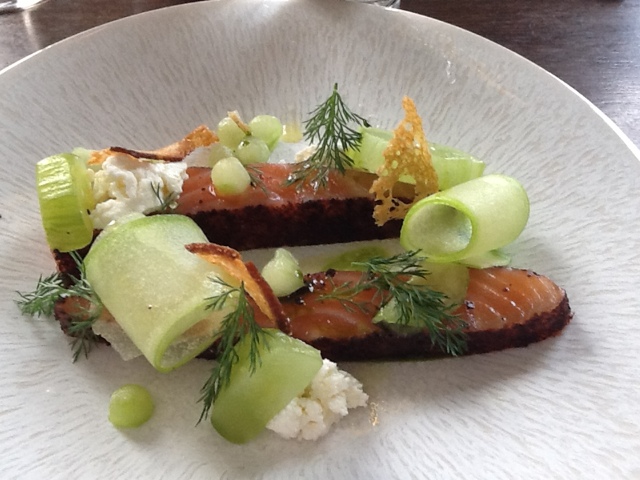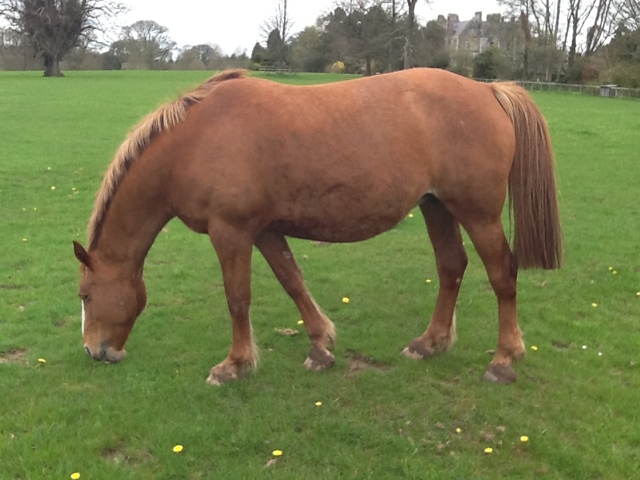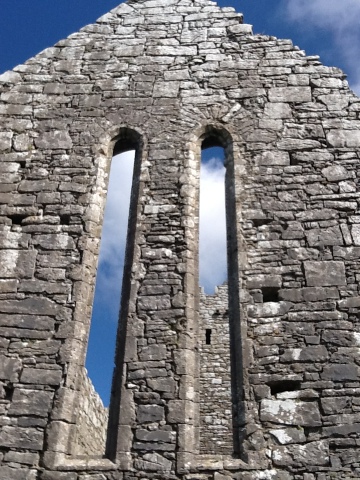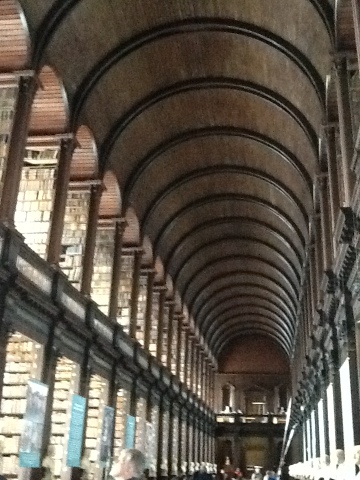Finally, I am reminded by a favorite artist and storyteller that hey, anyone can slay a dragon, but waking up every day, to love the world all over again, that's what takes a Real Hero.
Thanks to Brian Andreas and the folks at StoryPeople for permission to use this artwork.
And thanks to everyone who has been supportive during the journey.
Love,
Mary
Monday, April 29, 2013
Sunday, April 28, 2013
Farewell Dublin Dinner at The Pig's Ear
Wandering Nassau Street I located this gem after a tip for a local guide, and after a delicious dinner one evening, decided to make the Chef's Counter 12 course sampling dinner the culminating meal of the journey. Irishman Stephen McAllister prepared dinner Saturday night for the select few of us in the intimate space on the top floor. A beautifully choreographed dinner for 9, we got to experience the best of the local and seasonal dishes. Yep, that's chocolate soup on the menu.
Next time I'll bring friends!
Next time I'll bring friends!
And now a word from our sponsor . . .
On a lighter note, what's a visit to Dublin without visiting the home of Guinness? Thank you, Arthur, for perfecting the pint of porter and for the savvy signing of a 9000 year lease at the St. James Gate property in Dublin, for something like £400 up front and £45 annually . . . .uh huh.
Friday, April 26, 2013
How long? How long must we sing this song?
Touring Northern Ireland and Belfast was truly a unique history lesson. I visited West Belfast, home of Shankill murals, Bombay Street and the wall put up to keep violence from erupting during the Troubles, from the mid 1960's until the Good Friday Agreement in 1998. U2 provided the background music in my head.
And it's true we are immune
When fact is fiction and TV reality
And today the millions cry
We eat and drink while tomorrow they die
-Sunday Bloody Sunday, U2
The first picture show a line of women holding hands in August 1970 attempting to protect the police from the protesters throwing rocks. It's a long and complex history, and still pains the people who lived through it and lost loved ones, on both sides. The second picture shows a message, made of photos from Shankill area residents. And the final 2 pictures are from a memorial on Bombay Street. Here' s 2 links to help you brush up on the complex events of the Troubles.
http://youtu.be/ny91Pbt-7X0 Interviews of Bombay Street Residents
http://youtu.be/pdWd8WGQSxM Burning of Bombay Street Historical Photos unearthed
And it's true we are immune
When fact is fiction and TV reality
And today the millions cry
We eat and drink while tomorrow they die
-Sunday Bloody Sunday, U2
The first picture show a line of women holding hands in August 1970 attempting to protect the police from the protesters throwing rocks. It's a long and complex history, and still pains the people who lived through it and lost loved ones, on both sides. The second picture shows a message, made of photos from Shankill area residents. And the final 2 pictures are from a memorial on Bombay Street. Here' s 2 links to help you brush up on the complex events of the Troubles.
http://youtu.be/ny91Pbt-7X0 Interviews of Bombay Street Residents
http://youtu.be/pdWd8WGQSxM Burning of Bombay Street Historical Photos unearthed
Blarney and an Irish Draught
Venturing out to County Cork, the Blarney Castle and House are home to the famous magical stone, once kissed, supposed to gift the kisser with the gift of eloquence. Where the stone came from is typically Irish . . . some say it was the Lia Fái, see an earlier post this week on the Hill of Tara . . . .hmmm. Now, the fun part of Ireland really is in the mischievous, the story-telling, the delicate varnishing of the truth, known as blarney, versus baloney . . . truly just horseshit.
So I share with you a view from the top of Blarney Castle and a chestnut resident of Blarney House, a Scottish baronial-style mansion that was built on the grounds in 1874.
The day finished up with another kind of Irish Draught in Abbeyliex, in an old pub called Morrisey's. It first opened as a grocery in 1775, when it started life as a thatched one-storey house and in 1880 it was rebuilt as the lofty two-storey premises we see today, with high shelf-lined walls and a pot belly stove to gather round on cold days.
So I share with you a view from the top of Blarney Castle and a chestnut resident of Blarney House, a Scottish baronial-style mansion that was built on the grounds in 1874.
The day finished up with another kind of Irish Draught in Abbeyliex, in an old pub called Morrisey's. It first opened as a grocery in 1775, when it started life as a thatched one-storey house and in 1880 it was rebuilt as the lofty two-storey premises we see today, with high shelf-lined walls and a pot belly stove to gather round on cold days.
Tuesday, April 23, 2013
Leaning Cathedral Walls, Foxy Friars and the Crypt of Christ Church
The city center of Dublin has been home to this Anglican cathedral since the 11th century, and from this first picture, if you sense the left side falling out, you'd be right! The tile of the sanctuary floor sport the pilgrim-making foxes, as the monks of the day apparently became quite wealthy. And finally, I felt right at home in the large crypt, where I had an afternoon tea and treat, sitting on a pew bench.
Connemara & Kylemore Abbey
The sights of Western Ireland this day brought the daily rainbow, but this spot with a wild mountain goat was particularly worthy of a memory. The mountains here are regularly shrouded in a "scarf and hat" as one guide put it. At nearby Kylemore Abby, originally a 15,000 acre private homestead of the Mitchell & Margaret Henry family built in the mid 19th century, the Benedictine sisters have recently closed the private girls school for lack of population and funding. Renovation of the Victorian walled gardens and glass houses are underway, developed well ahead of its time by the progressive and experimental Mr. Henry.
Stone of Destiny
The Lia Fáil is a stone at the Inauguration Mound on the Hill of Tara in County Meath, Ireland, which served as the coronation stone for the High Kings of Ireland. It is also known as the Coronation Stone of Tara.
From this vantage point, the sweeping views of the Emerald Isle were quite fantastic. The Lia Fáil was thought to be magical: when the rightful High King of Ireland put his feet on it, the stone was said to roar in joy. The stone is also credited with the power to rejuvenate the king and also to endow him with a long reign. No telling what it might do if the Queen touched it.
From this vantage point, the sweeping views of the Emerald Isle were quite fantastic. The Lia Fáil was thought to be magical: when the rightful High King of Ireland put his feet on it, the stone was said to roar in joy. The stone is also credited with the power to rejuvenate the king and also to endow him with a long reign. No telling what it might do if the Queen touched it.
Brú na Bóinne
The Boyne River Valley in County Meath is home to a UNESCO World Heritage Site of megalithic passage tombs, dating back to the Stone Age and Neolithic people. Newgrange is the largest and only accessible site in as many as 40 in the Bend of the Boyne, as it is called, and may have been a place for ancestors, or house of the spirits. Ireland is home to nearly 1500 such sites, most of them small and properly untouched in farmland, as the Irish people are either superstitious or respectful, or both, of such sacred sites. Cremation was the norm of the day, and the ashes, bones and remains were placed inside. There is a comfortableness in being uncertain of many of the anthropological details, as Viking marauders would have plundered many sacred sites, as well as anyone else who may have come and scratched their names into the inner chamber since the rediscovery at the turn of the 17th century. What does remain is a roof box that allows sunlight to enter the passage tomb, larger enough only for a dozen adults to inhabit comfortably, with a 25 foot entrance, for about 20 minutes during the Winter Solstice week.
The connected tri-spirals are similar to other historical symbols, but unique on the entrance stone and several other spots here because of the connected and unending line.
The connected tri-spirals are similar to other historical symbols, but unique on the entrance stone and several other spots here because of the connected and unending line.
Meeting on the Turret Stairs, Sir Frederick William Burton 1864
Hellelil and Hildebrand, as this watercolor is also known, was voted last year as the Irish people's favorite work of art. The Danish version of Romeo and Juliet, brilliant blues and bright oranges are on display at the Irish National Art Gallery, as the ill-fated lovers make a final embrace on the stairway.
Saturday, April 20, 2013
O . . . Oscar!
Dublin is the birthplace of Oscar Wilde, playwright, poet, author, and this spot in the Merrion Square Garden is dedicated to him, across the street from his family home. He's remembered for the novel The Picture of Dorian Gray, the play The Importance of Being Ernest, and epigrams, like these:
Only dull people are brilliant at breakfast.
Whenever people agree with me I always feel I must be wrong.
The well-bred contradict other people. The wise contradict themselves.
Nothing looks so like innocence as an indiscretion.
A cynic is a man who knows the price of everything and the value of nothing.
Life is not complex. We are complex. Life is simple and the simple thing is the right thing.
Punctuality is the thief of time.
Oscar Wilde died in Paris on my birthday, sixty five years before I was born. Not exactly an epigram, but I'll keep working on it . . .
Only dull people are brilliant at breakfast.
Whenever people agree with me I always feel I must be wrong.
The well-bred contradict other people. The wise contradict themselves.
Nothing looks so like innocence as an indiscretion.
A cynic is a man who knows the price of everything and the value of nothing.
Life is not complex. We are complex. Life is simple and the simple thing is the right thing.
Punctuality is the thief of time.
Oscar Wilde died in Paris on my birthday, sixty five years before I was born. Not exactly an epigram, but I'll keep working on it . . .
Corcomroe Abby, St. Maria de Petra fertilis
So, part of the fun of travel and Language is understanding history and influences. This 12th century Abby near an area called The Burren on the Western coast of Ireland, essentially a limestone and somewhat barren region, as the water sinks through as the soil has long eroded from the seaside wind, sun, and shale/limestone bedrock.
I'm not sure, but I think the plaque naming the site means St. Mary of the Fertile Rock. As a gardener, that's a hopeful thought! In the last picture you can clearly see the contrast to the blue sky, the soil-less hills, and the heather growing near the gravesite.
I'm not sure, but I think the plaque naming the site means St. Mary of the Fertile Rock. As a gardener, that's a hopeful thought! In the last picture you can clearly see the contrast to the blue sky, the soil-less hills, and the heather growing near the gravesite.
Cliffs of Moher, County Clare
The sun was shining non-stop this day along the 200m cliffs facing the Atlantic Ocean, a fine treat. Spectacular views of the windswept coast.
There are no strangers
Only friends who have never met.
~W.B. Yeats, Irish Poet
Sharing a Guinness with new friends, a couple from London, and directly across from me, Harish and Usha, doctors from India, 60km outside of Mumbai. We were traveling along the west coast of Ireland, where our day tour stopped for lunch at a pub and we were able to sit outside for lunch on an unusually sunny day.
~W.B. Yeats, Irish Poet
Sharing a Guinness with new friends, a couple from London, and directly across from me, Harish and Usha, doctors from India, 60km outside of Mumbai. We were traveling along the west coast of Ireland, where our day tour stopped for lunch at a pub and we were able to sit outside for lunch on an unusually sunny day.
The Long Room, Old Library, Trinity College, Dublin
A significant collection of books and "Drawing to the Page" exhibit on Irish Artists & Illustrators from 1830-1930.
Friday, April 19, 2013
Turning Darkness into Light
Trinity College Library in Dublin, Ireland is home to the Book of Kells, a lavishly decorated version of the 4 Canonical Gospels in Latin, associated with St Collum Cille, 6th century founder of the Monastic Community of Iona, off the coast of Scotland. Scholars still disagree about exactly where and when this work was done, but place it roughly in the 8th century. The Book of Kells is displayed under dim preservative light, and is fairly darkened, given that the materials used is animal hide, calf vellum, and is more than 1200 years old. Many of the pages have been beautifully digitally preserved, and there's an App for that, and a cold URL link for you:
http://digitalcollections.tcd.ie/home/index.php?DRIS_ID=MS58_003v
Given my cosmovision of love and the transformative energy that flows through it, I was particularly struck with the title of the preliminary exhibit of the 4 texts on display, chosen from the last line of this Irish monk's poem during the same century, translated. Copying texts was a regular duty of Monastic communities, and not easy to do in Latin.
Pangur Ban
I and Pangur Bán, my cat
'Tis a like task we are at;
Hunting mice is his delight
Hunting words I sit all night.
Better far than praise of men
'Tis to sit with book and pen;
Pangur bears me no ill will,
He too plies his simple skill.
'Tis a merry thing to see
At our tasks how glad are we,
When at home we sit and find
Entertainment to our mind.
Oftentimes a mouse will stray
In the hero Pangur's way:
Oftentimes my keen thought set
Takes a meaning in its net.
'Gainst the wall he sets his eye
Full and fierce and sharp and sly;
'Gainst the wall of knowledge I
All my little wisdom try.
When a mouse darts from its den,
O how glad is Pangur then!
O what gladness do I prove
When I solve the doubts I love!
So in peace our tasks we ply,
Pangur Bán, my cat, and I;
In our arts we find our bliss,
I have mine and he has his.
Practice every day has made
Pangur perfect in his trade;
I get wisdom day and night
Turning darkness into light.
Translated by Robin Flower
http://digitalcollections.tcd.ie/home/index.php?DRIS_ID=MS58_003v
Given my cosmovision of love and the transformative energy that flows through it, I was particularly struck with the title of the preliminary exhibit of the 4 texts on display, chosen from the last line of this Irish monk's poem during the same century, translated. Copying texts was a regular duty of Monastic communities, and not easy to do in Latin.
Pangur Ban
I and Pangur Bán, my cat
'Tis a like task we are at;
Hunting mice is his delight
Hunting words I sit all night.
Better far than praise of men
'Tis to sit with book and pen;
Pangur bears me no ill will,
He too plies his simple skill.
'Tis a merry thing to see
At our tasks how glad are we,
When at home we sit and find
Entertainment to our mind.
Oftentimes a mouse will stray
In the hero Pangur's way:
Oftentimes my keen thought set
Takes a meaning in its net.
'Gainst the wall he sets his eye
Full and fierce and sharp and sly;
'Gainst the wall of knowledge I
All my little wisdom try.
When a mouse darts from its den,
O how glad is Pangur then!
O what gladness do I prove
When I solve the doubts I love!
So in peace our tasks we ply,
Pangur Bán, my cat, and I;
In our arts we find our bliss,
I have mine and he has his.
Practice every day has made
Pangur perfect in his trade;
I get wisdom day and night
Turning darkness into light.
Translated by Robin Flower
Subscribe to:
Posts (Atom)

















































